Common Data Leakage Threats and How to Combat Them

In today's digital age, the protection of sensitive data has become a critical concern for individuals and organizations alike. With the ever-expanding threat landscape, it is essential to be aware of the common data leakage threats and take proactive measures to combat them. In this article, we will explore various common data leakage threats, including USB drives, web/internet, file transfer, email, printer copiers, cameras, instant messaging, paper email, social media, and data disposal. We will discuss strategies and best practices to mitigate these threats effectively. 1. USB Drives USB drives have become an integral part of our daily lives, providing a convenient way to transfer and store data. However, they also pose a significant data leakage threat. USB drives can be easily lost or stolen, potentially exposing sensitive information to unauthorized individuals. To combat this threat, organizations should implement policies that restrict the use of USB drives or enforce en...
